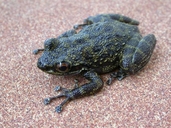|
Odontobatrachus natator (Boulenger, 1905)
Saber-toothed Frog, Sierra Leone Water Frog | family: Odontobatrachidae genus: Odontobatrachus |
| Species Description: Boulenger, G. A. (1905). Descriptions of new West-African frogs of the genera Petropedetes and Bulua. Annals and Magazine of Natural History, Series 7, 15, 281-283. (Link) | |
 © 2005 Theodore Papenfuss (1 of 5) |
|
|
|
Description The forearms of O. natator are somewhat slender, but also muscular and hypertrophied. The fingers are also slender, and the relative finger lengths are III > IV > II > I. The subarticular tubercles are distinct and subconical in shape. There are no supernumerary tubercles. The fingertips are triangular and enlarged (Barej et al. 2015 Zoosyst). The hind limbs are also slender and muscular, and have small round glands running across the upper side of the tibia. The inner metatarsal tubercle is elliptical and distinct. The toes have relative lengths IV > III > V > II > I. The toe tips, like the fingertips, are triangular and enlarged. There are subconical subarticular tubercles on the toes, and they are distributed as such: 1, 1, 2, 3, 2, respectively on toes I - V respectively. There are no supernumerary tubercles. The webbing is fully developed, and is nearly straight, barely concave. The webbing formula is 0 - 0.5/0 - 1/0 - 1/1 - 0 (Barej et al. 2015 Zoosyst). There are prominent folds on the feet posteriorly. The dorsal skin is varied, and there are slender dorsal ridges present on the dorsum and the flanks. The venter is smooth (Barej et al. 2015 Zoosyst). Odontobatrachus natator is assigned to the Odontobatrachus genus due to its tusk-like teeth on the lower mandible, distinct vomerine teeth, and curved teeth on both the premaxillaries and the anterior maxillaries. When compared to its congeners, O. natator is smaller than O. arndti and O. smithi, and larger than O. fouta and O. ziama. Odontobatrachus natator has a less extensive webbing than O. ziama, and more extensive webbing than in O. arndti, O. fouta, and O. smithi. The femoral glands of O. natator are rose-coloured, but are bright orange in O. fouta, pale orange in O. smithi, and dark orange in O. ziama (Barej et al. 2015 Zoosyst). Coloration: In preservative, adult O. natator are generally brownish but can also be greenish and light brownish. The dorsum is darker than the venter, and the throat is darker than the belly. The venter lacks marbling and patterns (Barej et al. 2015 Zoosyst). There appears to be sexual dimorphism in O. natator, as females are distinctly larger than males, having an average snout-vent length of 53.6 mm, as opposed to the male's average snout-vent length of 48.0 mm. Females also have longer limbs, fingers, and toes, broader heads, and more elongated snouts. However, the proportions of females are very similar to those of males, and the coloration of O. natator does not seem to be sex-dependant. The webbing formula varies among O. natator individuals. The number of dorsal ridges also varies in the species, ranging from two to six ridges. Coloration in life varies from uniformly brownish, to greenish or light brownish background color with mottling of dark spots. Ventral coloration ranges from very pale, to entirely dark, and everything in between (Barej et al. 2015 Zoosyst). Distribution and Habitat Country distribution from AmphibiaWeb's database: Cote d'Ivoire, Guinea, Liberia, Sierra Leone
Life History, Abundance, Activity, and Special Behaviors Larva Odontobatrachus natator larva only has minute morphological differences from other larvae in the genus. Odontobatrachus natator are one of the smaller tadpoles and the only tadpoles to exhibit white tail tips. Additionally, O. natator, as well as O. smithi, has tail fins of equal height, while the dorsal fin is taller in O. arndti, O. fouta, and O. ziama. The margin of the dorsal tail fin in O. arndti is curved, whereas it is straight in O. natator as well as in O. fouta, O. smithi and O. ziama. There are also small differences in the length of the anterior keratodont rows, from the tip of the snout to the mouth opening, with O. nator having the same lengths as O. fouta and O. smith of 3 > 2 = 4 > 1 verses 4 = 3 > 2 > 1 in O. arndti, and 3 = 2 > 1 > 4 in O. ziama. Furthermore, the round tubercle-like marginal papillae in O. natator, O. fouta, and O. smithi is in contrast with the short, round marginal papillae in O. arndti and the blunt-triangular marginal papillae in O. ziama. However, these differences should only be used for diagnosis in combination with locality and genetic information (Doumbia et al. 2018). Coloration in life, larval O. natator are light to dark brown, both dorsally and laterally. There is sometimes mottling of dark brown, light yellow, or even reddish spots. The oral disc region and also spiral guts are silvery-grey or white. The ventral region is a pink flesh-toned. The tail fins are translucent and grey, and the tail tips are either black, or more commonly, white (Doumbia et al. 2018). In preservative, the overall dorsal coloration of larval O.natator fades to light beige. The dorsal surfaces, including the tail, retain their darker brown mottled patterning. There are also dark brown patches that are especially pronounce in the loreal region. The tail has a medial, dark brown strip. The tail fins are slate black but often have a white tip. The background color of the flanks and venter is whitish. On the ventral surface, there is a dark line from the tip of the snout to the vent (Doumbia et al. 2018). Trends and Threats Possible reasons for amphibian decline General habitat alteration and loss Comments The specific epithet "natator" means "swimmer", thus named for its webbed feet. It is also known as a torrent frog, inhabiting rapid-flowing streams (Boulenger 1905). Phylogenetics: After the distinction of O. natator from the Petropedetes genus in 2013, there were initially only two species in the Odontobatrachus genus: Odontobatrachus natator, and an undescribed second species (Barej et al. 2015 Zoosyst). However, in 2015, Barej et al. found that the Odontobatrachus genus was actually composed of 5 distinct species: Odontobatrachus arndti, O. fouta, O. natator, O. smithi, and O. ziama. Phylogenetic analysis of the 16S, 12S, cyt b mitochondrial genes, and BDNF, SIA, and Rag1 nuclear genes, it was found that O. natator was sister to a clade formed by O. arndti and O. ziama. The clade formed by these three species is sister to a clade formed by O. fouta and O. smithi (Barej et al. 2015 BMC). This species was featured in News of the Week May 30, 2022: In most frogs, adults are considered to be primarily carnivorous with only a few species known to consume non-animal matter regularly. Schäfer et al. (2022) thoroughly investigated plant ingestion in all five species of the West African frog genus Odontobatrachus and two similar sized, sympatric species. The authors convincingly demonstrate that Odontobatrachus species are deliberately eating the leaves of the riparian tree Parkia bicolor through a combination of stomach-flushing hundreds of frogs across populations and seasons, a detailed capture-mark-recapture study, and a feeding experiment. Despite consuming large quantities of this particular leaflet, however, it does not appear that the frogs digest this plant material, and thus it is unclear why they are eating it. Overall, this study provides important insights into the diets of a unique frog radiation and highlights exciting areas for future research to better understand plant ingestion in this unusual group. (Written by Rayna Bell) This species was featured in News of the Week March11, 2024: Chemical signalling in frogs is only poorly understood but is expected to be far more common than currently known. Thus far, all cases of proven or suggested chemical communication in frogs are based on skin-derived chemical cues; however, internal tissues may likewise be involved in sequestering communication chemicals in frogs. Schäfer et al. (2024) analysed the volatile chemical composition and the general anatomy of a fatty strand, embedded in the lower jaw of both sexes of West African Saber-toothed Frogs (Odontobatrachidae) and discovered a previously unknown, internal structure which produces sex-, species- and mating related chemical cues. The chemical properties leave little doubt about the breeding related signalling function of the strand’s secretions. Just how the five Odontobatrachus species, use and excrete these cues remains a mystery. Given the anatomical placement and close association with calling related structures it is likely that the chemical cues complement the acoustic signals that both sexes emit. Though preliminary, the Odontbatrachidae add a new dimension to frog communication, highlighting that a deeper look, beyond the salient most obvious signals can be worthwhile. (Written by Marvin Schäfer)
References
Barej, M. F., Penner, J., Schmitz, A., Rödel, M.-O. (2015). ''Multiple genetic lineages challenge the monospecific status of the West African endemic frog-family Odontobatrachidae.'' BMC Evolutionary Biology, 15(67). Barej, M. F., Rödel, M.-O., Loader, S. P., Menegon, M., Gonwouo, N. L., Penner, J., Gvozdik, V., Gunther, R., Bell, R. C., Nagel, P. Schmitz, A. (2013). ''Light shines through the spindrift - phylogeny of African torrent frogs (Amphibia, Anura, Petropedetidae). .'' Molecular Phylogenetics and Evolution, 71, 261-273. Barej, M. F., Schmitz, A., Günther, R., Loader, S. P., Mahlow, K., Rödel, M-O. (2014). ''The first endemic West African vertebrate family - a new anuran family highlighting the uniqueness of the Upper Guinean biodiversity hotspot.'' Frontiers in Zoology, 11(8). Barej, M. F., Schmitz, A., Penner, J., Doumbia, J., Sandberger-Loua, L., Hirschfeld, M., Brede, C., Emmrich, M., Kouamé, N. G. G., Hillers, A., Gonwouo, N. L., Nopper, J., Adeba, P. J., Bangoura, M. A., Gage, C., Anderson, G. and Rödel, M.-O. (2015). ''Life in the spray zone – overlooked diversity in West African torrent-frogs (Anura, Odontobatrachidae, Odontobatrachus).'' Zoosystematics and Evolution, 91(115-149). Boulenger, G. A. (1905). ''Descriptions of new West-African frogs of the genera Petropedetes and Bulua.'' Annals and Magazine of Natural History, Series 7, 15, 281-283. Doumbia, J., Sandberger-Loua, L., Schulze, A., Rodel, M-O. (2018). ''The tadpoles of all five species of the West African frog family Odontobatrachidae (Amphibia, Anura).'' Alytes, 36 (1-4), 63-92. IUCN SSC Amphibian Specialist Group. 2019. Odontobatrachus natator. The IUCN Red List of Threatened Species 2019: e.T89114149A16927936. Downloaded on 29 January 2021. Originally submitted by: Alice Drozd (first posted 2021-01-29) Trends and threats by: Michelle S. Koo (updated 2022-05-29)
Comments by: Michelle S. Koo (updated 2022-05-29)
Edited by: Ann T. Chang, Michelle S. Koo (2024-03-10) Species Account Citation: AmphibiaWeb 2024 Odontobatrachus natator: Saber-toothed Frog <https://amphibiaweb.org/species/3742> University of California, Berkeley, CA, USA. Accessed May 19, 2025.
Feedback or comments about this page.
Citation: AmphibiaWeb. 2025. <https://amphibiaweb.org> University of California, Berkeley, CA, USA. Accessed 19 May 2025. AmphibiaWeb's policy on data use. |



 Map of Life
Map of Life